
Ecommerce Growth Hacks To Implement Today in 2024
“Growth hacking” is the latest buzzword to capture the attention of entrepreneurs and startups. But what exactly is growth hacking and how can it help your dropshipping business to grow and scale? In this blog, we’ll deep dive into the history of growth hacking, the concepts behind the practice, and the best ecommerce growth hacks to achieve exponential growth for your online business.
What exactly is growth hacking?
Growth hacking is a marketing strategy focused on achieving exponential growth through low-cost, innovative and unconventional strategies. The term was coined by entrepreneur Sean Ellis in 2010 in a blog post titled “Find a Growth Hacker for Your Startup”. Ellis describes growth hackers as “a person whose true north is growth”, meaning everything they do is to drive sustainable growth. Unlike traditional marketing approaches that may rely heavily on large budgets and long-term campaigns, growth hacking emphasises continuous testing of experimental tactics to achieve quick (but sustainable) growth. They operate at the intersection between marketing, product and technology, targeting any area that affects customer acquisition, activation and retention.

How can it apply specifically to ecommerce and dropshipping?
Though it was developed with SaaS companies in mind, growth hacking is perfectly suited to ecommerce and digital marketing. The same things that make ecommerce beneficial for startups make growth hacking a viable strategy to achieve exponential growth.
Cost-effective growth
Effective resource management is a top priority for startups with limited working capital. Growth hacking emphasises low-cost solutions, which not only saves businesses money in the short term but allows them to invest in other areas to support long-term growth.
Focus on scalability
Growth cannot be achieved without scaling. While growth will help you boost sales, scaling will help you maintain that growth and maximise profits without increasing your costs. Growth hacking helps businesses optimise every aspect of their operations to achieve exponential but also sustainable growth.
Data-driven decision making
Growth hackers are always looking for unconventional ways to achieve growth, but their ideas are never without reason. Growth hackers are experts at gathering and analysing data, ensuring they only bring the best ideas to the table. Expert growth hackers will know their target audience inside and out, keep tabs on the competition, and be informed of the latest trends and viral campaigns.
Flexible strategies
Growth hacking may focus on short-term gains compared to traditional marketing, but it is anything but short-lived. Through constant experimentation and learning, growth hackers can keep up with the fast-paced ecommerce landscape, ensuring your business is always at the forefront of technology and marketing.
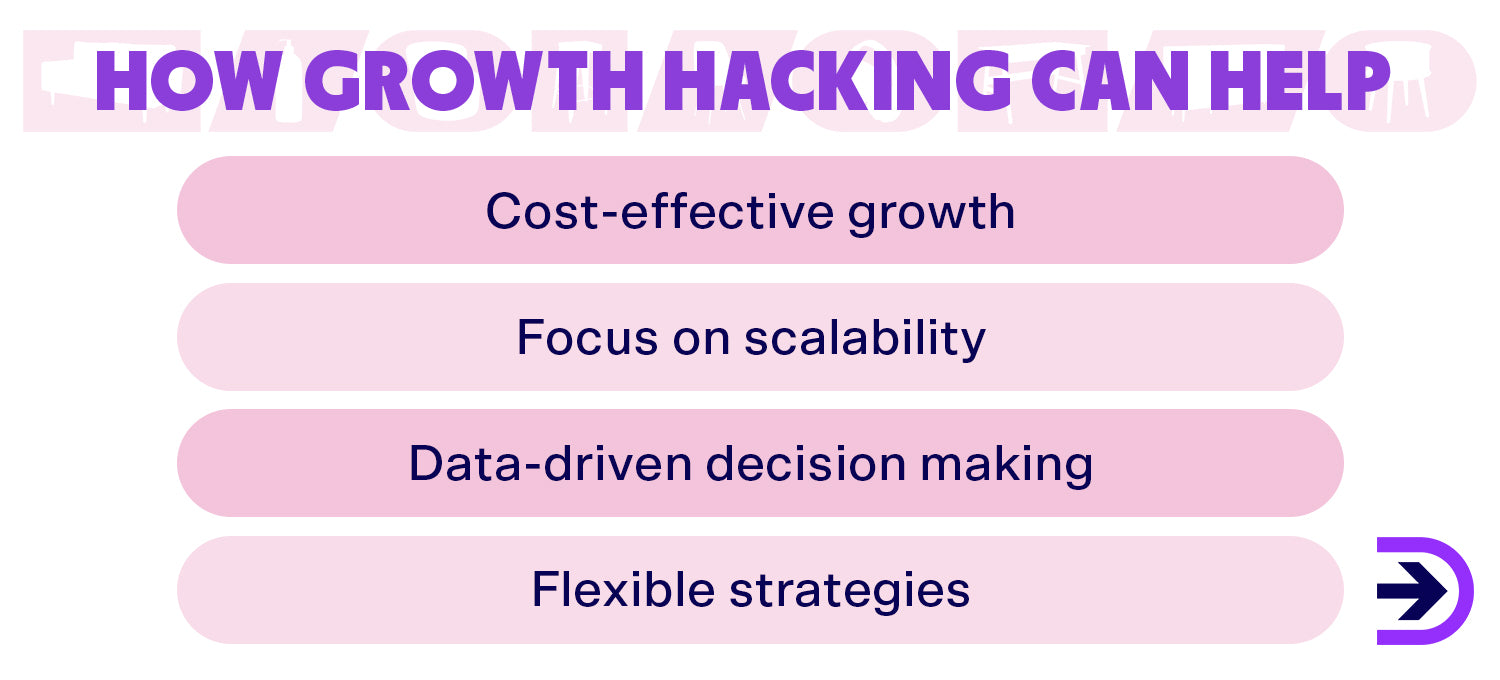
Excited to get started with growth hacking? Here are the top growth hacking strategies you can use with your ecommerce business today.
On-page growth hacking strategies to trial
1. Producing FOMO
Fear of Missing Out (FOMO) refers to a feeling of apprehension or anxiety that consumers will be left out of something, and appeals to a sense of urgency and loss aversion. Although the term has only been around since the 2000s, FOMO taps into basic human desires to connect and belong. Because it’s so ingrained in humans, it is an incredibly effective psychological hack to use for growth hacking. Millennials are especially susceptible to FOMO, with 60 per cent of millennials likely to make a reactive purchase within 24 hours of experiencing FOMO.
There are many ways you can produce FOMO on your website.
Scarcity
Showing when an item is low in stock tells customers that the item is popular and limited, creating urgency. Customers need to buy now, or they’ll miss out on a limited-time product or offer. You can even take advantage of sold-out inventory. In this 2021 study, participants were more likely to buy a USB cable when 50 per cent of the options were marked as sold out than when no sold-out options were present. This “sold-out effect” occurs because people perceive sold-out products as high-quality: if other people bought it, it must be good. You can even go one step further and encourage customers to sign up for restock notifications.
Exclusivity
Limited-edition product releases, VIP events, and exclusive deals create anticipation and excitement among your target audience. Exclusivity not only triggers FOMO, but it helps to cultivate brand loyalty by making customers feel special and appreciated.
Sales countdown timers
Make visitors watch the clock using a countdown timer with a clear deadline. These timers provide a powerful visual cue that time is running out. This encourages users to engage with your site for longer and make decisions faster. Loss-averse customers won’t want to miss out on the chance to save money - even if they might not have spent it otherwise.
Exit-intent pop-ups
Exit intent pop-ups detect when consumers are about to leave your website and deliver targeted offers. These may include exclusive sign-up deals, one-off product discounts, “last chance to buy” promotions, or other engaging content that will keep the customer on your website.
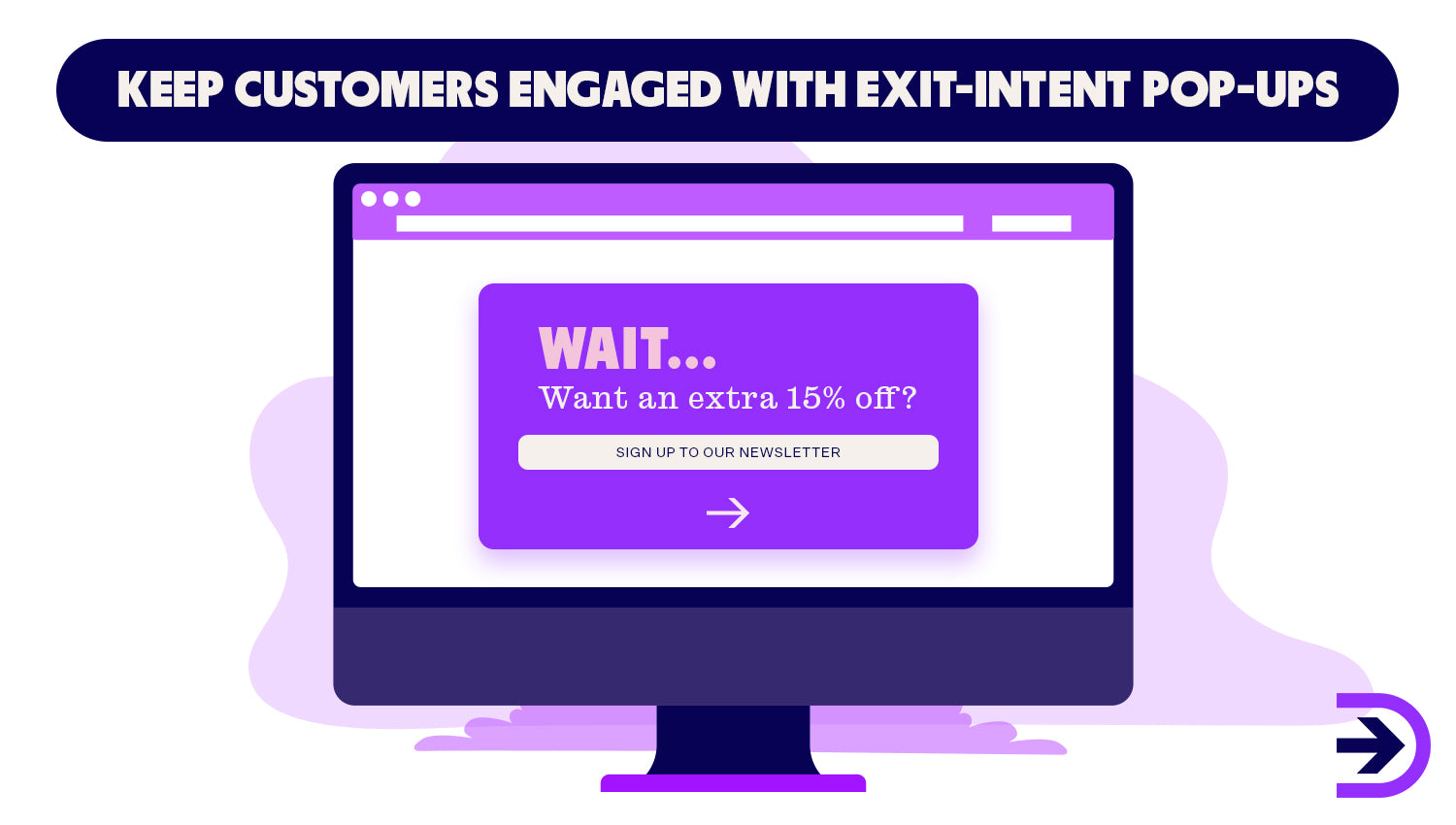
2. Improving user experience and site speed
A core goal of growth hacking is to acquire and retain customers, and the quickest way to do this is to make your ecommerce website easy to use. User experience (UX) design is another core feature of growth hacking, and refers to the process of designing and building products that are accessible and comfortable to use. UX design is crucial for ecommerce businesses. 88 per cent of customers are less likely to return to an ecommerce website after a bad experience, and it’s estimated that a staggering $2.6 billion in annual revenue is forfeited due to slow site loading times. That’s a lot of revenue businesses are losing to problems that, with the right tools, can be easily fixed.
Look for pain points along the entire customer journey
There are many types of pain points a customer might experience in their journey with your ecommerce brand:
-
Support pain points: Points where customers cannot find adequate customer support.
-
Productivity pain points: Points that may hold up your business due to lack of automation, inefficient communication or inadequate documentation.
-
Financial pain points: Points where the customer might hesitate due to their financial situation, such as when it comes to shipping.
-
Process pain points: Points where customers encounter issues with internal processes such as poor site navigation, lengthy wait times, or difficult return processes.
Identifying pain points across the entire customer journey is crucial for improving the overall customer experience and driving business growth.
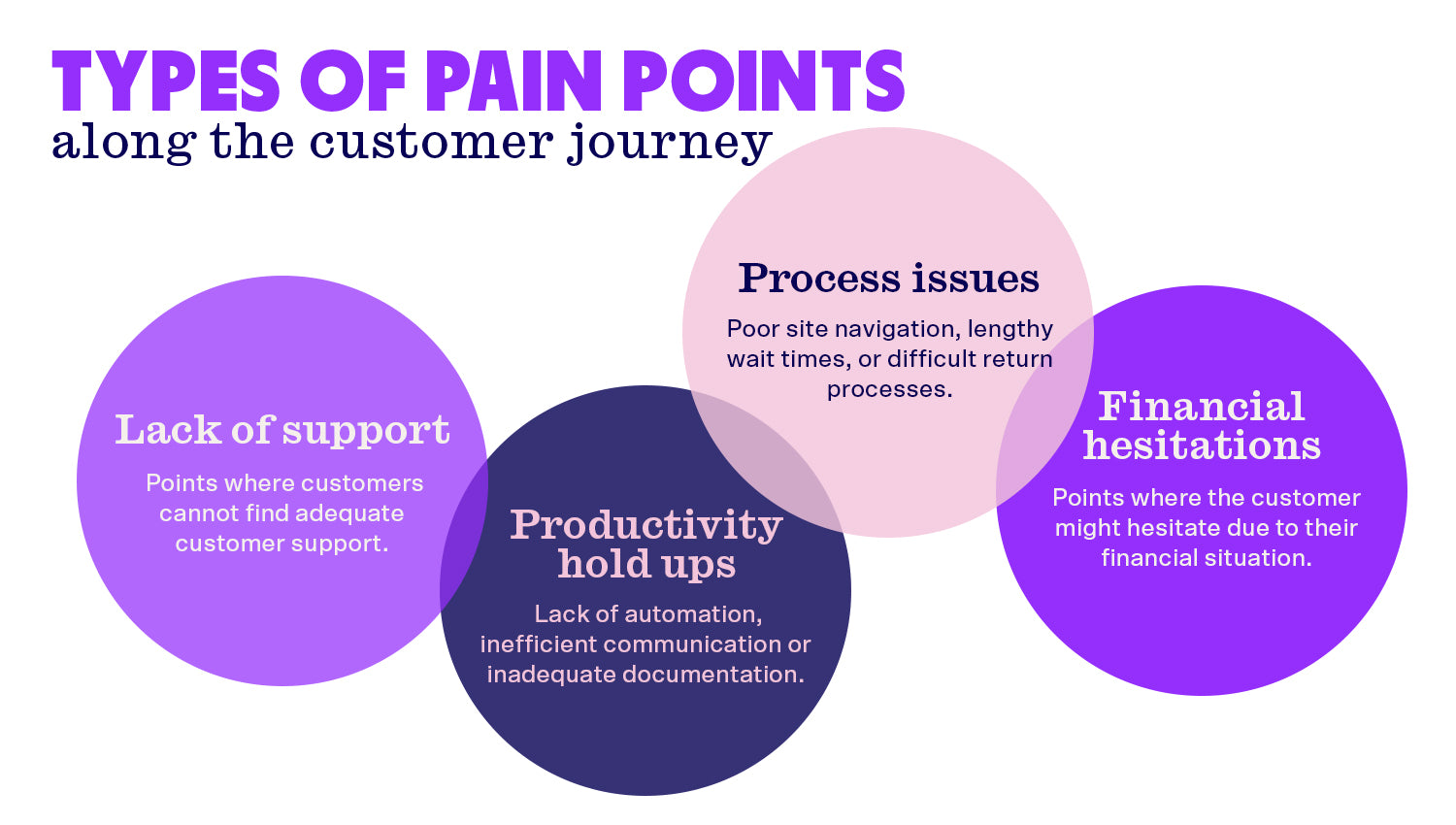
Prioritise function to improve your site speed
Site speed has been shown to directly affect several aspects of ecommerce including conversion rates, SEO, and customer loyalty. According to Google, 53 per cent of mobile sites are abandoned if they take longer than 3 seconds to load. Even a one-second delay can lead to a 7 per cent or more drop in conversions. As users become less tolerant of delays, having a site speed of under three seconds becomes crucial to a site’s success.
Some easy things you can do to improve your site speed include using mobile-first designs, optimising your images and videos, removing unnecessary pop-ups, and regularly auditing your plugins. While image is important, design your websites with function in mind - there’s no point using fancy imagery if customers will never see it!
Optimise navigation
Complicated site navigation leads to high bounce rates and can prevent SEO crawlers from indexing important pages. Here are some tips for designing clear site navigation:
-
Ensure your navigation menu is easy to find and understand. Use clear, instructive labels.
-
Stick to standard styles. For example, using horizontal drop-down menus for mobile devices.
-
Put your most important menu items at the start and end of your navigation menu. This takes advantage of the serial position effect, where users pay more attention to/are more likely to retain the first and last aspects of a list.
-
Use a hierarchical structure for your navigation, with main categories leading to subcategories as needed.
-
Keep your menu simple. Ideally, your menu should contain no more than 5-7 items.
-
Use visual cues, such as arrows, to indicate where users need to click and which menu items contain subcategories or additional information.
Conduct A/B testing
A/B testing, also known as split testing, is a method used to compare two versions of something to see which one performs better. In ecommerce, A/B testing often involves creating two different versions of a webpage, email, ad, or other content, and showing each version to different groups of people to see which one gets better results. For example, if you want customers to click on a specific CTA button, you might show one group a blue button while the other sees a red button. By measuring how many people click on the button, you’ll determine which colour is most effective, and you can use that data to inform future campaigns. Growth hackers love A/B testing because it is low-risk, low investment, and provides actionable insights that lead to better outcomes for both businesses and consumers.

Use the right tools
You don’t need to hire a consultant or be a technical expert to measure your ecommerce site performance. There are many free or affordable tools available for businesses to optimise their ecommerce sites. Here are some of the top tools to determine your ecommerce site health:
Google Core Web Vitals: Show how your pages perform with Google’s Core Web Vitals.
Google PageSpeed Insights: Reports the user experience of your website on both mobile and desktop.
Hotjar: Provides visual insights using heat maps and real-time user session recordings to analyse user behaviour and identify pain and frustration points.
Ubersuggest’s A/B Testing Significance Calculator and Website Traffic Checker: Measures the effectiveness of A/B testing and monitors site traffic.
Pingdom Website Speed Test: Used to measure and troubleshoot site loading times.
Mozilla Observatory: Scans websites for potential security risks.
3. Social proof
Social proof is a psychological phenomenon where people copy the behaviour of others to make the correct or most desirable decision. Like FOMO, this makes it an effective tool for growth hacking, as it can deliver results with minimal effort. In ecommerce, reviews and testimonials act as social proof for products and brands. Around 95 per cent of consumers read reviews while shopping online, and 49 per cent trust online reviews as much as personal recommendations from family and friends.
There are many types of social proof:
-
Reviews and testimonials
-
Awards
-
Case studies
-
Influencer/celebrity endorsements
-
Expert endorsements
-
User-generated content (UGC)
-
Social media shares
-
Wisdom of the crowds
-
Wisdom of your friends

Show real-time purchases/downloads
Live sales pop-ups are notifications that appear on your website when a customer makes a purchase. These sales act as real-time reviews, showing other customers that people are not only visiting, but purchasing from your site, increasing legitimacy. They can also help induce FOMO and encourage customers to make a purchase decision or complete a CTA, increasing conversions.
Highlight fast/best-selling products on category pages
Displaying your best-selling products at the top of your category pages and using tags such as ‘bestseller’, ‘selling fast’ or ‘limited stock’ can pique customer interest, induce FOMO, and encourage engagement. By prominently featuring best-selling products, you’re also directing attention to items that have already proven successful in driving sales, which leads to higher conversion rates.
Encourage reviews
Reviews act as important social proof for your dropshipping business. 93 per cent of users say online reviews impact their purchasing decisions, and positive reviews can increase customer spending by 31 per cent. Encourage customers to leave reviews for your business wherever possible, and display your favourites in prominent areas, including your product pages.
Show who’s talking
Whether people are talking about you on social media, nominating you for awards, writing about you in case studies or writing headlines in the news, mention these on your website. You might show a live follower count, show recent media highlights on your social feed, create a news tab or feature articles on your blog.
4. Content marketing
Content marketing is integral to growth hacking, and one of the most effective ways to stand out in a competitive online market. Well-crafted content can support the entire customer journey, from awareness to consideration to conversion. By creating relevant content that educates, entertains, and addresses the needs and interests of their audience, businesses can reduce friction, build trust, raise brand awareness, and increase conversions. Content marketing also plays a crucial role in SEO. By creating content that aligns with relevant keywords or search queries, brands increase their visibility in search engine results pages (SERPs), driving organic traffic and attracting quality leads to their website.
Here are some ways you can optimise your content marketing strategy today.
Use relevant keywords
Keywords are the cornerstone of effective content marketing and SEO. You can find relevant keywords by looking at search engine suggestions, using free keyword research tools such as Wordstream or Ubersuggest, or using competitor analysis tools to see what keywords your competitors use.
Offer high-value content
The more value you can offer with your content, the more engagement you’ll receive. High-value content not only generates goodwill from consumers, but it establishes credibility and authority in your field. High-value content can be entertaining, educational, or engaging. In each case, the customer walks away with valuable information and/or inspiration. When making high-value content, consider what your audience might need from your products or brand and how you can deliver. For example, a fashion brand might release a seasonal style guide, while a tool brand might teach customers how to use their products with video tutorials.
Audit your content regularly
Content audits help you determine what content is working for your business. Using tools such as Google Analytics, you’ll see which pages consistently perform well, which pages are trending, and which pages need to go. These audits can also help you to improve SEO, refresh outdated content, and improve your overall site performance.
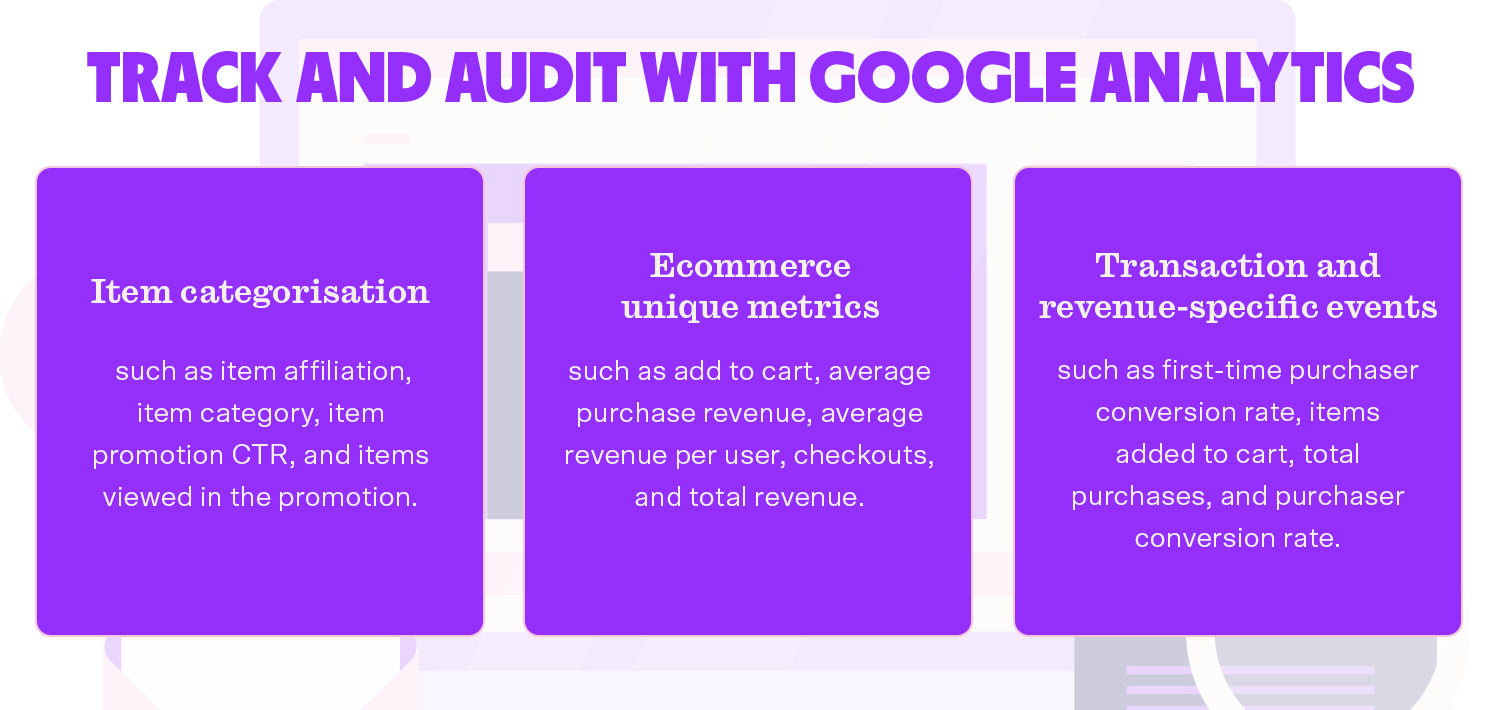
Repurpose, repackage and recycle
When writing content, consider every way the information can be used and distributed so you can get the most out of your marketing efforts. With some tweaking, a blog post can easily become a social media caption, an infographic, an educational video, or the basis of a whitepaper. You can even turn your best-performing articles or blogs into a downloadable ebook.
Off-page growth hacking strategies to trial
1. Referral programs
Referral programs encourage existing customers to refer friends, family, or acquaintances to a business in exchange for incentives or rewards. It leverages the power of word-of-mouth marketing, where satisfied customers act as brand advocates and recommend products or services to prospective customers within their network. This has the same effect as social proof - getting people to talk about your brand makes others more likely to purchase from you.
A key benefit of referral programs is that they generate high-quality leads. When customers receive a positive impression of your business from someone they trust, they are more likely to convert. This makes referral programs an incredibly effective tool in your growth hacking arsenal, both in terms of results and cost. Other benefits of referral marketing include higher retention rates, increased average order value, and increased customer lifetime value. This is because customers who refer their friends to their favourite brands become invested in the business’s success. Additionally, new customers who are referred often spend more on their initial purchases thanks to the trust instilled by the referring party. Both of these conditions foster brand loyalty and create repeat buyers, increasing lifetime customer value and reducing acquisition costs.
2. Segmented email marketing
Email marketing is one of the most effective marketing channels in 2024. Despite massive technological and societal shifts in social media usage, email marketing consistently outperforms social media marketing with higher click-through rates, higher conversion rates, and higher ROI. Email marketing allows for more direct, targeted and personalised campaigns, and it is also easy to experiment with and measure, making it an excellent tool for growth hackers.
Segmentation is an important concept for growth hacking. Market segmentation involves separating target audiences into groups based on specific demographic, psychographic, behavioural or geographic characteristics. Marketers can then analyse these groups in-depth, uncover their goals and motivations, and develop personalised marketing campaigns to address them. Used with ecommerce email marketing, segmentation leads to 30 per cent more opens and 50 per cent more click-throughs than unsegmented marketing. Because this content is highly relevant to the target audience, customers are also less likely to send your emails to spam or unsubscribe. Overall, segmentation allows you to deliver a better customer experience, which leads to better growth outcomes for your dropshipping business.

Thanks to email marketing automation tools, it’s never been easier to set up a segmented email marketing strategy. Use tools such as MailChimp, Zapier and Shopify Email Automation to identify audience segments, create customisable templates, personalise customer interactions, and send emails automatically with the right trigger.
3. Retargeting ads
Retargeting is a marketing technique that targets potential customers who have shown interest in a product or service but have yet to complete a CTA. The goal is to bring these consumers back to your website to complete the desired action. Retargeting is a high-value, cost-effective strategy because these customers are already interested in your product, increasing the likelihood of becoming a paying customer. By offering special promotions or discounts, businesses can even incite FOMO, increase customer loyalty, and build stronger customer relationships. Like segmented marketing, retargeting can be personalised based on a variety of factors such as browsing behaviour, purchase history, interests or demographics.
Traditionally, retargeting worked by placing a cookie on a user’s browser that allowed businesses to track their browsing behaviour once they left their website. For example, a customer looking for shoes might visit your online store, and view your bestselling shoes, but not complete a purchase. Cookies allow your business to re-advertise your shoes to this customer across other websites, tempting them to come back and buy your shoes. However, with Google planning to phase out third-party cookies in 2024, growth hackers are finding other creative ways to show retargeting ads to potential customers without using cookies. Some platforms have developed solutions that enable targeting while protecting privacy, such as Google’s Protected Audience API or Facebook’s Conversions API. Retail media networks are another solution. These digital advertising platforms leverage their extensive consumer data and digital infrastructure to offer valuable advertising space to brands. First-party data collection is a key factor in each of these strategies and will be a defining feature of many ecommerce growth strategies in 2024.
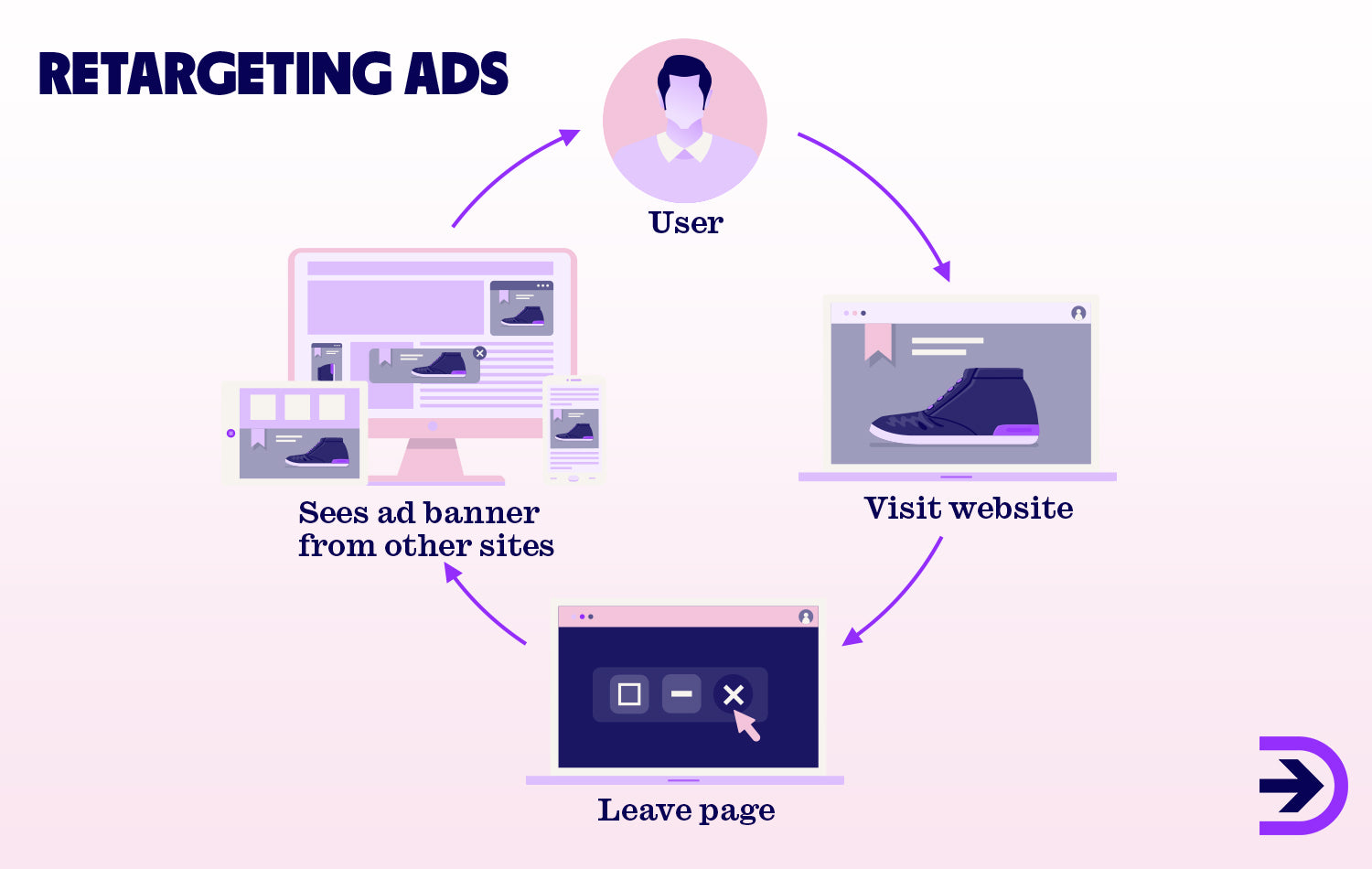
4. Contests and giveaways
Contests and giveaways are a great way for online businesses to quickly generate traffic, leads and engagement across multiple platforms. Unlike other marketing methods, contests and giveaways offer a dynamic and interactive experience that resonates with consumers in the digital age. By offering enticing prizes or exclusive deals that reward customers, ecommerce businesses can capture the attention of their target audience and incentivise them to take action, whether sharing brands with friends, creating user-generated content, signing up to a mailing list, or making a referral.
Businesses can leverage contests and giveaways in a variety of ways. Firstly, contests and giveaways provide ecommerce businesses with valuable opportunities to collect first-party customer data. By requiring participants to provide contact information or complete a survey as a condition of entry, businesses can expand their subscriber base and use the data to inform future marketing campaigns.
Secondly, promotions and giveaways can drive engagement. The element of competition and the chance to win something valuable creates a sense of urgency, anticipation and FOMO, encouraging customers to actively participate and engage with the brand. This heightened customer engagement increases brand visibility and fosters a sense of community and loyalty among participants, driving long-term customer retention and advocacy.
Finally, contests and giveaways offer ecommerce businesses the opportunity to creatively showcase their products. Whether contests are part of a product launch, seasonal promotion or a UGC campaign, these initiatives allow ecommerce brands to generate buzz and excitement around their offerings. These product placements can drive traffic to their website, increase sales, and ultimately grow revenue.
5. Influencers and collaborations
Partnering and collaborating with influencers is one of the most effective marketing methods of the digital era. Social media has made influencer marketing an accessible outlet for brands and creators, leading to a proliferation of influencers of various sizes and niches. Because influencers often specialise in niche topics or demographics, they allow brands to target specific audiences easily and at scale. Through authentic and relatable content, influencers are able to develop a deep relationship with their target audiences, and their perceived expertise lends credibility to their recommendations. This is why 69 per cent of consumers trust influencer recommendations when it comes to purchases, and 91 per cent of millennial consumers trust online reviews as much as recommendations from friends and family. By leveraging the trust and authority of influencers, brands can accelerate the growth of their customer base and establish themselves as reputable players in their ecommerce industry.

There are many ways dropshipping businesses can implement and measure influencer marketing campaigns. Many influencers participate in affiliate marketing or referral programs, where they are incentivised to create quality content in return for a commission. Some social media platforms have built specialised hubs for brands and influencers to collaborate, such as TikTok’s Creator Marketplace. Brands can also reach out to influencers directly for sponsorships or collaborations.
Growth hacking success stories
Canva
For the first few years of its life, design giant Canva barely invested in marketing. Yet the platform still managed to grow rapidly, gaining 800,000 users within 2 years of launch. Today, Canva is valued at $40 billion and has over 5 million paying subscribers. Most of this growth was achieved through simple word-of-mouth marketing. Canva’s unique selling proposition, the key to its ongoing success, lies in its user-friendly interface and intuitive design tools, allowing users to create professional-style graphics without experience, training, or expensive software. To demonstrate this, Canva targeted social media content creators and marketers, offering free access to the tool in exchange for sharing their creations. For content creators using graphics every day, this was an easy win. In 2014, Canva also launched a design school to provide valuable educational content, helping more users learn both the platform and the basics of design. This firmly established the platform as an authority figure, fostering customer engagement and loyalty at scale. This organic growth was further fueled by Canva's strategic partnerships and integrations with popular platforms like Dropbox and Google Drive, seamlessly integrating its tools into existing workflows and expanding its user base.
Dropbox
How does one company achieve 3900 per cent growth within months? Through the power of referrals. With growth hacking, Dropbox was able to tailor one of the most effective referral programs of all time. First, they made their referral program part of the onboarding process. As the final onboarding step, they offered users a clear incentive: up to 16GB of free space in exchange for referrals. They made it easy for users to invite friends in multiple ways. Users could share a referral code over their preferred communication channel, send bulk invites over email, or share via their social media channels. Since referrals were worth 500MB each, it was easy for customers to see how big their storage was getting, which became a motivator to reach the promised 16GB. Finally, users who converted via referral were awarded 500MB upfront, then promised more space if they invited friends and family in turn, creating a viral loop. By creating a 2-sided referral program where both users benefitted, Dropbox achieved continuous, fast growth with minimal investment.
Daniel Wellington
While backpacking in 2011, Swedish entrepreneur Filip Tysander was inspired by a chance encounter with Daniel Wellington, a man wearing a vintage Rolex. The sleek and timeless style of the watch piqued Filip’s interest and he decided to create his own line of watches. From there, it only took three years for the watch brand Daniel Wellington to reach $228 million in sales. In 2017, the brand was ranked as the fastest-growing private company in Europe.
Daniel Wellington’s success can be attributed to influencer marketing. Daniel Wellington offered micro-influencers free products and personalised promotion codes. Considering the brand’s high profit margins per product, this was an incredibly affordable alternative to paid sponsorship. They collaborated with influencers across various industries, from fashion to music. Once posts started rolling in, they heavily invested in user-generated content. The #DWpickoftheday hashtag was especially popular with influencers, with 58.6K posts at the time of writing. Winning posts were featured on Daniel Wellington’s official Instagram, leading customers to create even more content for the chance to be featured by a big-time brand. As one of the first brands to truly leverage influencer marketing, Daniel Wellington is a perfect example of the effectiveness of social proof for growth hacking.
Choosing what's right for your ecommerce and dropshipping store
Is your dropshipping store ready to explore growth hacking? Our growth hacking checklist can help you decide whether growth hacking is the right direction for your business and show you how to get started.
-
Do you know your target audience?
-
Do you have a strong and sustainable business model?
-
Do you have a scalable product?
-
Do you have the right tools to monitor growth?
-
Do you have clear goals and KPIs for your business?
-
Do you have supportive and creative-minded leadership?
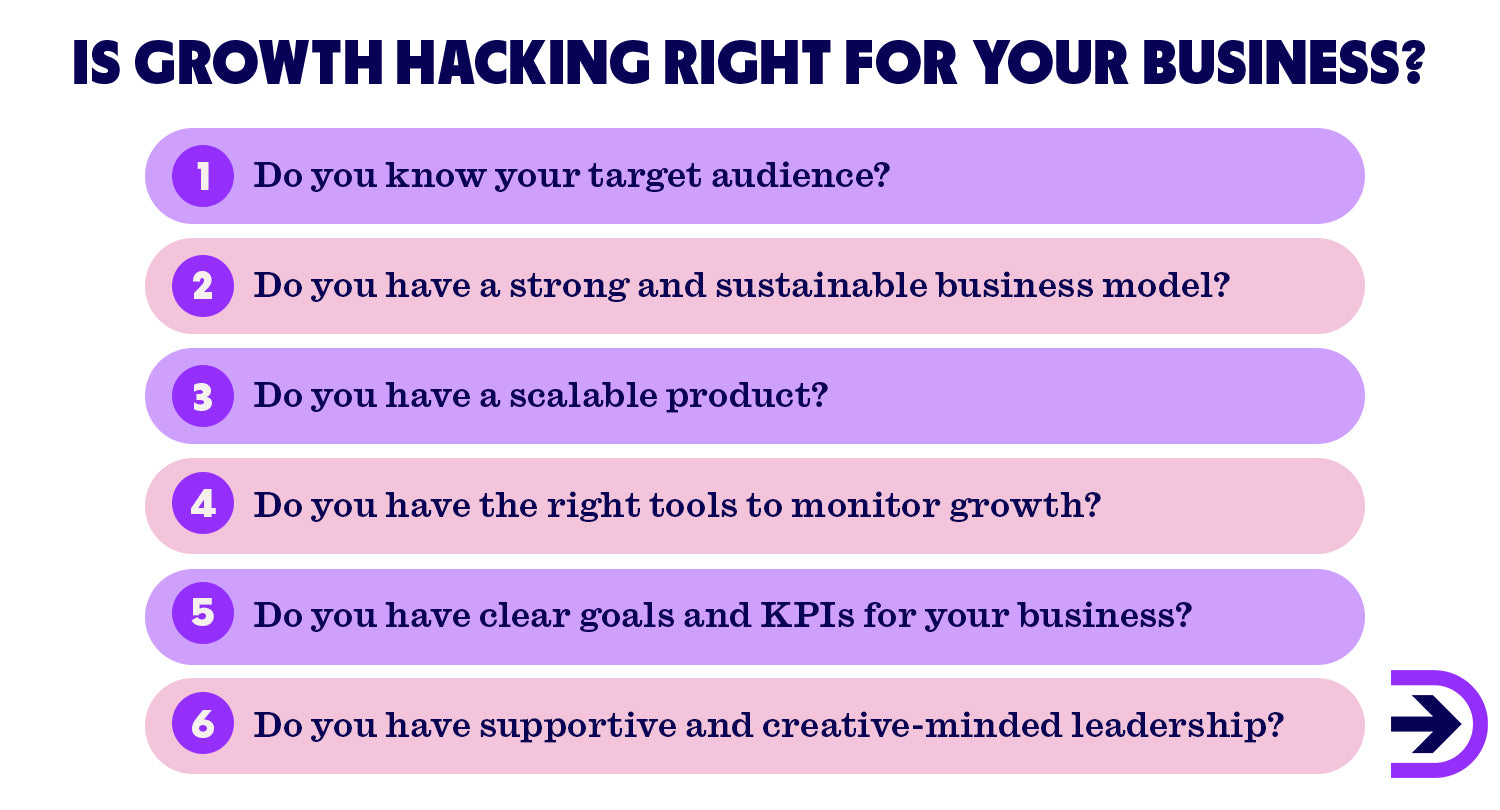
Dropshipzone can help ecommerce startups build the foundation for growth hacking. Like growth hacking, dropshipping is designed with scale in mind. With low overhead costs, zero inventory and no logistics to manage, dropshippers can focus their efforts on marketing and acquisition. Dropshipzone facilitates communication between Retailers and Suppliers, making it easy for startups to find trending products, add them to their ecommerce store, and rapidly scale. With a wide range of products available, you can test new products and markets with minimal risk or profit loss. Our Suppliers are local to your target market, cutting shipping times and last-mile delivery costs. Sign-up is completely free, with no hidden fees or minimum order quantities. With Dropshipzone as your foundation, there's no limit to your growth hacking potential. Don’t wait - start scaling today.

